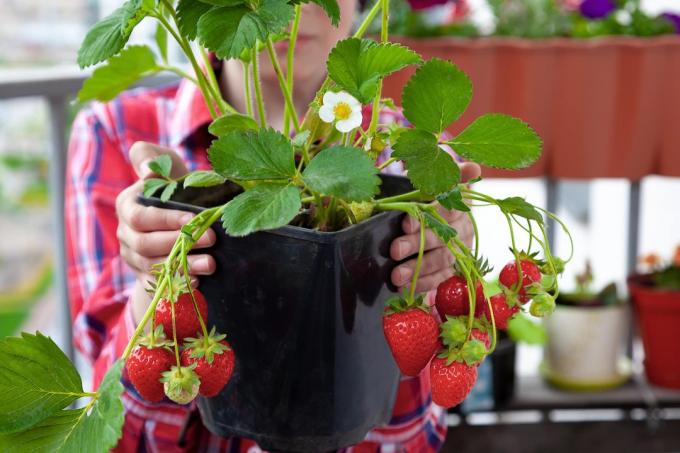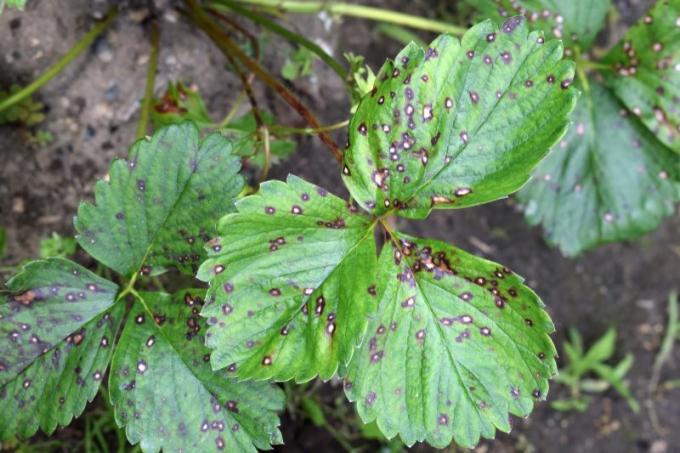
Climbing strawberries are a visual eye-catcher and invite you to have a sweet snack in between. So that the plants thrive optimally and offer aromatic strawberries, there are a few things to pay attention to when planting and caring for them.
In a nutshell
- Climbing aid essential
- plenty of moisture for large fruit
- Be careful with mineral fertilizers
Table of contents
- Characteristics
- Location
- Plant
- climbing aid
- attachment
- Care
- Pour
- Fertilize
- Cut
- harvest
- hibernate
- multiply
- offshoot
- seed
- diseases/pests
- frequently asked Questions
Characteristics
- growth: runner-forming; perennial
- growth height: up to 150 centimeters
- blossom: medium green
- heyday: June to October
- fruit: medium-sized; particularly sweet
- harvest time: June to October or hardest frost
- frost sensitivity: frost resistant
- use: climbing plant, self-cultivation

Location
In order for climbing strawberries to grow healthily and vigorously and bear numerous fruits, an ideal location is of great importance. This is characterized by the following properties:
- sunny; Partial shade provides less sweetness
- protected from wind and rain
- permeable, nutrient- and humus-rich and lime-poor soil or equivalent substrate
- soil pH between 6.0 and 7.0
Plant
Climbing strawberries can be placed in the garden bed and in tubs or planters. The following details must be taken into account:
- planting hole size: twice the size of the root area
- best planting time: from the beginning of April
- planting distance: from between 20 and 40 centimeters
- tub/box size: at least 30 centimeters in diameter
- planting depth: heart bud inside just above the surface of the earth
- water moderately

Tip: Climbing strawberries are best cultivated when they are planted as young plants or as an offshoot in a bed or bucket. Sowing is more complicated and the hoped-for germination often fails to materialize.
climbing aid
Climbing strawberries are not actually climbing plants, as they do not climb independently. You need one climbing aid, to which the tendrils are to be attached. The ideal time has come as soon as several tendrils are of the appropriate length.
Different types of climbing aids can be used. This can be a trellis or garden fence such as a chain link or hunter's fence. A height of 150 centimeters is important here and that they offer passages through which the climbing strawberries can be fixed.

Anyone who does not have a trellis in the garden or on the balcony can buy a trellis in stores. This is best suited for attachment to a raised surface, such as a wall or fence. Climbing spirals are particularly easy and space-saving to use. They are easy to stick into the ground.
attachment
Care should be taken when attaching climbing strawberries to a trellis. Some materials can cut into the shoots and disrupt supply routes. In addition, injuries are possible, which are ideal entry points for pathogens. The following fixing materials are best suited for tying:
- nylon stockings
- Natural or artificial raffia ribbon
- ring binder
- wide rubber band

Tip: When fixing to a trellis, always make sure that it is loose. The tip of the shoot may hang down, but not later slip out of the attachment due to the weight of the strawberries.
Care
Proper care is immensely important so that climbing strawberries remain healthy in the long term and promise a bountiful harvest.
Pour
Climbing plants have a high water requirement, especially during fruit formation, which is why the soil should always be evenly moist. They do not tolerate overwatering or even waterlogging and should therefore be avoided.
Fertilize
The administration with an organic strawberry or other berry fertilizer is recommended. Alternatively, leaf humus or bark compost is also suitable. Garden compost should be avoided, as well as mineral fertilizers, which are not well tolerated by the strawberry plants due to too many nutrient salts.
The first fertilization is done in spring, before the first flowers form. A second time is useful to help the strawberries ripen. If the climbing strawberries are weakened due to countless fruits, they can be fertilized again in September to be able to start the winter season stronger.

Tip: Always follow the manufacturer's instructions for dosage in order to avoid over-fertilization, which can lead to the death of the climbing strawberries.
Cut
With young plants, the foothills should be cut off regularly and the first flowers plucked so that the plant concentrate on the main shoots and ensure vigorous growth with sufficient energy and nutrients can. Brown, dried leaves should be removed for the same reason. All faded shoots are cut back in mid/end of October.
harvest
Depending on when the climbing strawberries are planted, the weather conditions and the variety, a harvest time between June and October can be expected. The ripe fruit can be cut off at the stem with garden shears. When pulling off with your fingers, make sure that the shoot is not pulled with it.

Harvest maturity can be recognized by the following characteristics:
- bright red fruit color
- previously white or yellowish edges are red
- intense strawberry smell
- Fruit can be dented all around
hibernate
Climbing strawberries are usually hardy. If the plants are cut down in autumn, the heart bud should be covered with fleece, straw, pine needles or brushwood at extremely low temperatures. Young plants are sensitive to cold and should always be covered from the first frost.

Climbing strawberries that are cultivated in pots, tubs or boxes should always overwinter in a bright, frost-free location with protection against the cold. With them, the cold penetrates unhindered to the roots. In addition, they may also need to be watered during the winter season so that they do not dry out completely.
multiply
There are two different methods of propagation:
offshoot
The increase should be done between late July and early August. The simplest method is to use rooted cuttings. They are separated from the mother plant, carefully lifted out and simply planted in nutrient-rich, loose substrate.
If there are no roots yet, the offshoot should be placed in a small container with soil and kept evenly moist. A separation from the mother plant takes place only when plenty of roots have formed. All offshoots should be planted by mid-August at the latest. Incidentally, offshoots have a variety guarantee. That means they have the same properties as the mother plant.
Tip: Offshoots that originate close to the mother plant are best suited for propagation. They are usually strong and larger and often flower the following year.
seed
Propagation by seeds is significantly less promising than through offshoots. In addition, there are occasional crossings, so that the harvest result can cause surprises. If you still want to try it, you will find the seeds on the skin of the fruit. This is to be peeled off thinly and the seeds then to be dried. If the seeds are to be stored until the following year, a dark, dry room is required.
Proceed as follows for sowing:
- Sow between June and mid-July
- Fill seed boxes or small pots with a sand/soil mixture or a nutrient-poor, sandy substrate (sand/soil ratio 1:1)

- Distribute seeds evenly over the surface of the soil and cover minimally with soil (light germinators)
- Cover boxes/pots with cling film to allow moisture build-up
- Location: bright, without direct sunlight; between 15 and 18 degrees Celsius
- Depending on the variety, germination takes between two and six weeks – then remove the foil
- prick out carefully after three to four leaves have grown and plant at the destination
diseases/pests
The following are some typical diseases and pests that affect climbing strawberries and can ruin the harvest if left unchecked.
gray mold:
- occurs mainly in humid weather during the flowering period
- dense, light gray mold on fruits
- Fruit rots from the inside
- Fungus overwinters in dead plant parts and fruit mummies
- Countermeasures: rain-protected location; Immediately cut off affected parts of the plant; radical pruning in autumn; Chop up 100 grams of field horsetail, leave to steep in one liter of water for 24 hours and spray the plant with the decoction every day for a week

strawberry spot disease:
- Spread mainly in summer
- increasingly burnt red or roundish, reddish-brown bordered spots with a white core on leaves
- dying leaf parts
- spores inside the leaf
- black spots in autumn/winter
- countermeasures: remove affected parts of plants immediately; Chop up 100 grams of field horsetail, leave to steep in one liter of water for 24 hours and spray with Sud Plant daily for a week; ensure sufficient planting distance

strawberry mite (Phytonemus pallidus fragariae):
- Pest 0.2 millimeters in size, light brown
- prefers young heart leaves
- usually from the second half of summer growth disorders with curled, stunted, brownish heart leaves
- Countermeasures: repeated spraying with onion, tansy or horsetail decoction

frequently asked Questions
The best climbing strawberry variety is currently the 'HUMMI', which impresses with its distinctive fruit flavor and a certain robustness. But also the varieties 'Klettertoni' and 'Parfum Freeclimber' convince with strong growth and aromatic fruits.
The difference lies in the shoot lengths. The shoots of climbing strawberries grow so long that they should be hung high. If they stayed on the ground, contact with the ground, especially with the fruit, would lead to mould, rot and snail damage.
They are very firm in their consistency and do not yet have the typical fine-sweet fruit aroma. The more immature they are, the less edible they are. Because they do not ripen, it is essential to ensure the right degree of ripeness, as described in the guide.



